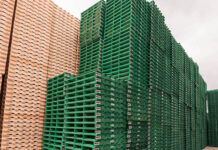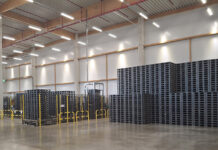Jim Hardisty, managing director of Goplasticpallets.com, discusses how the increase in automated facilities demands more from today’s plastic packaging
THE rapid rise in “e” and m-commerce in recent years has driven growth in large-scale distribution centres. As well as upscaling, retailers also face the need to refresh how their distribution sites run. Consequently, many have introduced automated systems to manage the workload and maximise output, without increasing outgoing costs.
However, while the number of automated facilities escalates, so does the need for precision-made, returnable plastic packaging that will thrive in these fast-paced environments.
As next and same delivery becomes the norm, there is a greater need to use the right, durable packaging that can promise uniform performance, in all kinds of automated systems.
Application first: Choosing the right solution
Before introducing new automated technology, decision makers should consider what will provide optimal performance.
Here, using the right plastic pallet or box for the application is crucial.
That’s why when advising customers on the best plastic pallet or box for their application, we look at a number of factors. Not only the size and type of pallet in use, but the system itself. The pressure it will apply to the packaging and importantly, the rotation cycle – the time between loading and unloading the pallet. This indicates the application’s speed and frequency handling.
Think of a picking tote in a major e-commerce fulfilment operation. The orders are picked, placed into totes, then packed for shipping. The tote is then reused – sometimes within minutes – hundreds of times a week. In contrast, some containers will go into background stock and sit untouched, so have a low number of annual rotations. Every scenario is unique and needs to be treated as so.
Innovation in plastic packaging
One of our manufacturing partners, CABKA-IPS, has been developing high-end, manufacturing techniques that will deliver sustainable, economic solutions.
Recently we’ve seen particular innovation in the development of three-piece Folding Large Containers (FLCs). Historically these containers have been produced using “thermo-forming” techniques, where heated sheets of plastic are stretched over a “form” to create the product.
However, this process can create stress points within the unit’s structure, weakening the base and lid. The solution: Employ injection moulding techniques for a more precise and reliable pallet container.
Injection Moulding
By comparison, injection moulding is a more effective manufacturing technique. It offers greater accuracy, consistency and a smoother product. Ideal for automation.
No stress is placed on the product during production, removing the likelihood of weak spots, so a more robust container is produced under pressure. It has a faster cycle time because advanced equipment is employed to inject the precise volume of material required for each part. It’s also more flexible, so product customisation is easier and units can be made to order more quickly, which is reflected in the price.
As a result, we launched The CabCube 1210 (pictured above), a three-piece FLC and our clients are already reaping the benefits from the injection moulding process. Manufactured of high quality recycled PP, the CabCube is made up of a collapsible sleeve, and an injection moulded base and lid. The unit is extremely lightweight, precise and resilient, perfect for automated facilities and transporting bulk items. And weighing only 39kgs, operatives can singlehandedly collapse the unit, saving space on return transport journeys.
The future developments of automation are unlikely to slow down but for now, it’s clear that to cope with consumer demand, distributors should invest in plastic!













